Nirit Weiss-Blatt's Blog, page 5
February 1, 2021
The Techlash Book is in production, but…
Here’s some background information
* From the Introduction: the Techlash definition and method summary
* From the Appendix: the list of interviewees.
The 130 pages between them tell the Techlash story in detail:
* When and why the tech coverage shifted to tech-backlash
* How the Big Tech companies defended themselves from scrutiny, over and over again, and how it too backlashed
* The lessons to be learned in both tech journalism and tech PR.
More info about those research findings – coming soon.
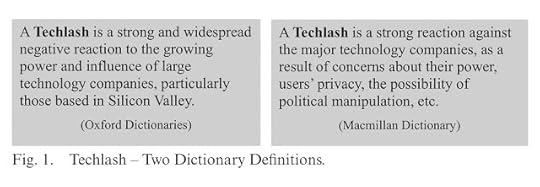
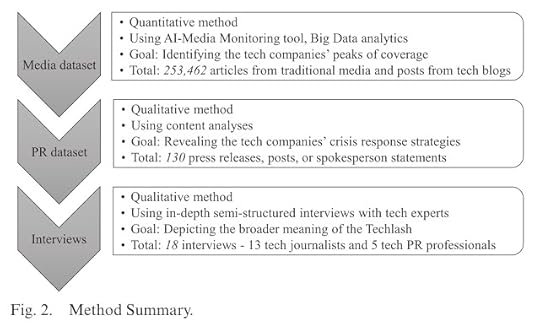
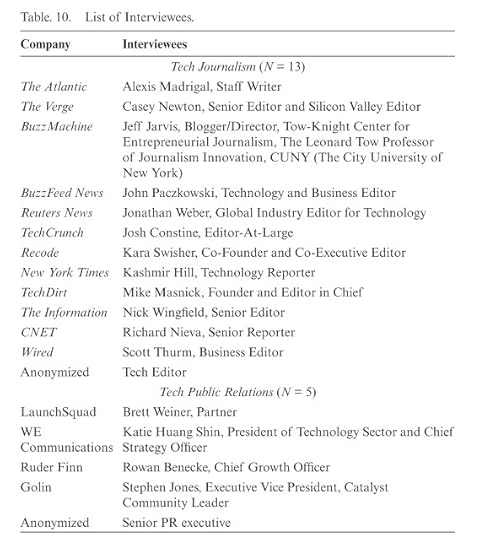
October 7, 2020
“All current signals point out that the backlash after November 2020 will surpass the one that originated in November 2016”
PRovoke (formerly, The Holmes Report) published an article about the Techlash. I’m glad that I could contribute to this piece and be featured alongside brilliant PR professionals. Here are a few snippets out of my interview. I recommend reading the whole story HERE.

Nirit Weiss-Blatt, Ph.D. and author of Techlash and Tech Crisis Communication, says what’s we’re seeing today began as a “post-election reckoning” in 2017, including Russian interference in the election, misinformation, extremist content, hate speech, cyber-attacks and data breaches.
“All current signals point out that the backlash after November 2020 will surpass the one that originated in November 2016 in magnitude,” she warns. “Some politicians and citizens will create total chaos, and tech would be blamed for all of it. The pendulum is drawn to such extreme. So, I don’t expect that the near future will help us reach any middle ground.”
The concept of the middle ground that we are among pendulum swings emerged in many interviews for this piece. For instance, we went from fawning stories on founders and the media awestruck by the trajectory of unicorns, to now, tech companies being framed as villains. There's plenty of evidence that tech players squandered the initial goodwill, but Weiss-Blatt says the picture is more nuanced.
“As you would expect, tech PR professionals think the media pendulum has swung too far in the negative direction,” she says, adding that as investigative tech journalists discovered scandals, others jumped onto the news cycle. But also, tech PR’s “infamous secrecy and limited access heavily contributed to where they are today.”
“We move from hero worship to villainy, but the next phase is to find a balance, most likely through adjustments in design and, possibly, regulation,” says Kim. “Those are the types of conversations we need to drive.”
And those conversations need to happen across multiple threads, as Weiss-Blatt points out, techlash spans the cultural and the political.
_ _ _ _ _ _ _ _ _ _ _ _ _ _ _ _ _ _
The article discusses the importance of companies taking a stand on social issues. In that regard, my host at USC, Fred Cook, the Director of the Center for Public Relations and the Chairman of Golin, initiated research on New Activism. It examined the PR industry’s views on activism and how prepared communicators are to react or work with various activist groups. I highly encourage to listening to his conversations with leading activists and PR executives in the #PRFuture podcast. I think that purpose-driven employees are actually a source for optimism, even when there’s not a lot of it left.
_ _ _ _ _ _ _ _ _ _ _ _ _ _ _ _ _
Update (10/30/2020): The full video of the "Techlash panel" is now on YouTube

March 24, 2020
Covid-19 & The Techlash
We used to complain about the big tech’s dominance.
Now, we heavily rely on them and are glad they exist.
The new virus changes so much in our world, and I won’t repeat all the apparent ramifications. However, an interesting trend emerged:Normal life grinds to a halt, but so does the Techlash (Tech-backlash), which dominated the tech coverage for the past three years.

While working on my upcoming book about the Techlash and “Tech Crisis Communication,” I realized that this pandemic is also affecting the tech companies’ coverage, so, I’m adding a new chapter to discuss it.
There’s still a lot of criticism, for example, about the spread of misinformation, but the change in the critical tone (actually complimenting the companies’ services and work) – is noteworthy.
In this short post, you are invited to see how this current trend started and developed.
* I promise to update it with new relevant articles:
March 15, 2020 When Facebook Is More Trustworthy Than the President The New York Times - Ben Smith
March 16, 2020 COVID-19 Reminds Us: Social Media Is Good, Actually Reason – Elizabeth Nolan Brown
March 17, 2020 As Politicians Are Still Looking To Destroy The Internet, Covid-19 Reminds Us WhySocial Media Is Not Just Good, But Saving Lives TechDirt - Mike Masnick
March 18, 2020 Tech's moment to shine (or not) Axios - Ina Fried
March 20, 2020Has the Coronavirus Killed the Techlash? WIRED - Steven Levy
March 21, 2020 Facebook has moved fast during coronavirus outbreak, and it could restore the company’s reputation CNBC - Salvador Rodriguez
Under quarantine, media is actually social TechCrunch - Josh Constine
OK, Fine, Let’s All Get Back on Facebook The Wall Street Journal - Joanna Stern
March 23, 2020 Big Tech Could Emerge From Coronavirus Crisis Stronger Than Ever The New York Times - Daisuke Wakabayashi, Jack Nicas, Steve Lohr, and Mike Isaac
* Update:
What Techlash? Virus could remake industry giants’ image The Information – Cory Weinberg
March 25, 2020 Will Covid-19 end the big tech backlash? The Interface – Casey Newton
April 1, 2020 Why a pandemic is bringing out our best online The New York Times – Shira Ovide
April 2, 2020
Keep calm and carry on: How the internet will see us through COVID-19 crisis ZDNet - David Gewirtz
April 6, 2020 Facebook and Google's coronavirus competition The Interface – Casey Newton
April 9, 2020
The Politics of 2020 Are Looking Less Ominous for Tech Bloomberg - Eric Newcomer
April 27, 2020
Tech giants are profiting — and getting more powerful — even as the global economy tanks The Washington Post – Elizabeth Dwoskin
* Update:
On the other hand:
May 1, 2020 The immunity of the Tech Giants The New York Times – Kara Swisher
May 1, 2020 How the virus could boomerang on Facebook, Google and Amazon Politico – Steven Overly and Leah Nylen
But, then again:
August 5, 2020 The Tech You Love The New York Times - Shira Ovide
"I’m a widowed great-grandmother in my tenth decade, living alone. My family is scattered all over the globe. WhatsApp, FaceTime, Zoom and Google Meet (with instant captions) have been a lifeline for me. Seeing my children and grandchildren’s faces and talking with them on a regular basis, sometimes daily, has made the lockdown and isolation bearable. I’m aware of the nefariousness of Big Data. But this technology cancels it out for me." — Blanche Korngold, Brookline, Mass.
February 22, 2020
The Best Tech Podcasts

L.A. has the worst traffic in the world. Since I’m spending most of my days on its bumpy roads, I decided to turn this unpleasant experience into something beneficial. This is how my tech podcasts’ addiction started.
They make the traffic problem bearable and help me keep my finger on the pulse of the tech industry. Win-Win. Now, I’m gladly sharing my recommendations with you.
* It is in NO particular order. I love them all.
Recode Decode
Description: Recode’s Kara Swisher hosts candid interviews with tech execs, politicians, celebrities, and more about their big ideas and how they’re changing our world.
Fascinating episode: “Anna Wiener: The dark side of the tech industry’s seductive culture.”
Warning label: You’ll wonder how Kara manages to do so much in one day while you’re just listening to one of her trillion in-depth interviews.
* In 2019, Recode Decode won the “Adweek Podcast of the Year” Award. Well-deserved. The queen Kara paved the way for all the others in the Vox kingdom and beyond.
Pivot
Description: With great power comes great scrutiny. Recode’s Kara Swisher and NYU Prof. Scott Galloway offer sharp, unfiltered insights into the way technology is shaping business and culture across media, advertising, politics, and more.
Fascinating episode: “Gloves off over privacy, from Apple to Microsoft to Grindr. PLUS Scott’s big 2020 bets.”
Warning label: You’ll start describing actions as a “Gangsta move!”
Reset
Description: Every story is a tech story. We live in a world where algorithms drive our interests, scientists are re-engineering our food supply, and a robot may be your next boss. Vox’s Arielle Duhaime-Ross explores why - and how - tech is changing everything.
Fascinating episode: “The Airbnb Scam.” Interviews with Mike Isaac and Allie Conti.
Label warning: You’ll start saying bye to friends using “Later, Nerds.”
Land of the Giants
Description: In less than two decades, Amazon CEO Jeff Bezos scaled an online marketplace for books into the world’s most valuable company. But at what cost? The podcast addresses Amazon’s rise to power with detailed, thought-provoking, measured reporting from host Jason Del Rey . This show offers never-before-told, behind-the-scenes stories for the Amazon-obsessed. * Season 2 would focus on Netflix - Can’t wait.
Fascinating episode: “Is Amazon Too Big? We Ask Its Sellers.”
Warning label: You’ll feel less good about yourself the next time you’ll order something using Amazon’s one-day delivery.
First Contact
Description: Laurie Segall hosts a weekly podcast series that explores the people and technology that are changing what it means to be human. First Contact brings listeners engaging and thought-provoking interviews with some of the biggest names in tech in ways we can all relate to.
Fascinating episode: “Ex-Facebook Security Chief Speaks Out on Russia & Spies in Silicon Valley.” An interview with Alex Stamos.
Warning label: You’ll start thinking about your first contact with the people around you.
TechDirt
Description: The Techdirt Podcast, hosted by Mike Masnick . Each episode begins with an essay, followed by a discussion, covering topic areas that are less news-driven and instead more about larger ideas/concepts that we think are worth discussing.
Fascinating episode: “The Past & Future of Section 230.” An interview with Prof. Jeff Kosseff.
Warning label: There are ways to make tech dirt-free. You’ll just need the right shovel.
The Information’s 411
Description: A weekly podcast by The Information, a subscription tech news site doing deep dives and investigative looks at the tech and media industries. Each episode highlights some of the major happenings in tech business world. It’s interviews, analysis, and wrap-ups to help give you insights into what the biggest companies in the industry are thinking. Host: Tom Dotan .
Fascinating episode: From all of the serious episodes, I decided to choose the funniest one: “Finding Humanity in (HBO’s) Silicon Valley.” An interview with Thomas Middleditch and Zach Woods, about the most hilarious (and sadly accurate) show about Silicon Valley.
Warning label: The rest of the coverage from “The Information” requires a subscription. Their reporting is always unique and important, but it’s your choice, of course.
Bonus: Five more episodes
From Business Casual : “All Nerds Not Welcome: Why Tech’s Diversity Problem Matters.” An interview by Kinsey Grant (Morning Brew Newsletter) with Reshma Saujani (Girls Who Code).
From This Week in Google : “Our Best of 2019.” Leo Laporte , Jeff Jarvis & Stacey Higginbotham are debating while presenting opposite perspectives on various tech stories.
From TED Talks Technology : “What obligation do social media platforms have to the greater good? | Eli Pariser .
From The Daily : “The End of Privacy as We Know It?” An interview by Annie Brown with Kashmir Hill, the technology reporter for The New York Times, about her Clearview-AI expose.
From Today Explained : “Shaken like a polarized picture.” An interview by Sean Rameswaram with Ezra Klein. Most of this podcast’s episodes are not really into tech, but they are incredibly informative. What can I say? Voxknows how to produce great podcasts.
Give them a listen and thank me later. If you have any additional recommendations, please do share.
November 26, 2019
Surviving the Techlash
This month, the annual Relevance Report was released from USC Annenberg’s Center for Public Relations. The report identifies emerging issues and forecasts topics and trends that will impact society, in fields like business and communications. My essay was about the evolving Techlash (tech-backlash), and you can either download the full report, the pdf of my piece, or just read it below.
I would love to hear your thoughts.
Surviving the Techlash
In the previous Relevance Report, I addressed the major shift in the tech industry, in which tech companies are experiencing recurring scandals and are “no longer a source of good, but also a source of the bad.” I claimed, “Consequently, the tech spokespeople need to adjust their crisis management know-how to manage the new combat era of Techlash.” They were advised to respond with, “we can’t fix this alone, and we are working together with others to find a solution.”
Since the Techlash keeps on evolving, we should be aware of its changes in order to assess future directions. The first step is to realize that the Techlash is here to stay.
The Increasing Tech Scrutiny
The past year was filled with negative coverage of the tech industry. Its leaders and their innovations are no longer worshiped, but rather under increased scrutiny. The coverage tone has shifted from “positive bias” to “negative bias” (focusing only on the downside of tech). The rise of “tech investigative journalism” resulted in numerous scoops regarding various corporate misdeeds. And the critics are demanding changes that are ranging from the essential to the impossible.
This critical tone is now unmistakable and everywhere, including tech events, as Axios’ Ina Fried described: “Not that long ago, what people wanted from a tech conference was to hear from executives about the next shiny object coming down the pipeline. But nowadays, tech CEOs aren’t talking about what’s fresh from their corporate ovens - instead, they’re the ones being grilled.”
Moreover, blaming tech companies for all the bad human behaviors (online and offline) became a common practice. You wish to get famous and adored? Talk against the tech companies. You wish to attract voters? Demonizing tech is “good politics.”
Government Action and #BreakUpBigTech
Despite several years of scandals, tech companies are still growing and successful. Their shares are skyrocketing after massive earnings reports. Consumers continue to heavily use tech products as if they can’t (or don’t want to) avoid them. In essence, tech is too dominant, convenient, and beneficial to boycott.
So, if usage is not affected by the techlash, what is? Consumers’ sentiment about government action: They are demanding more of it, leading to calls for tougher regulations, including the call to #BreakUpBigTech.
According to a recent YouGov survey, nearly two-thirds of Americans would support breaking up tech firms by undoing mergers, “if it means ensuring more competition in the future.” The poll showed that the support is bipartisan and that on the extreme ends there is even more eagerness.
Such polls don’t provide the trade-offs of government action, such as degrading services, the ability to fight “malicious actors,” and raising prices. But the techlash has generated an upsurge of active probes into tech companies: The Justice Department, the Federal Trade Commission, the House Judiciary Committee, the House Financial Services Committee, and the State attorneys general - are all investigating Facebook, Google, Amazon, and Apple about their competition and privacy practices.
Overall, tech companies and their representatives should adjust to a new ecosystem of aggressive tech opponents that includes conservatives and liberals, regulators, antitrust and privacy advocates, tech workers, scholarly tech critics, and tech journalists (who may regret decades of “cheerleading” tech).
Responsibility, Transparency, and Corrective Action
Because of the increased scrutiny, tech companies need to sharpen their communication strategies.
First, companies are required to take more responsibility. As Apple CEO Tim Cook recently stated, “If you built a chaos factory, you can’t dodge responsibility for the chaos.” For example, tech companies constantly blame their algorithms: On the one hand, they glorify their core technology for solving many societal problems, on the other, they quickly blame the same technologies for any wrongdoing. It is absurd. Stop blaming the machine. People built it.
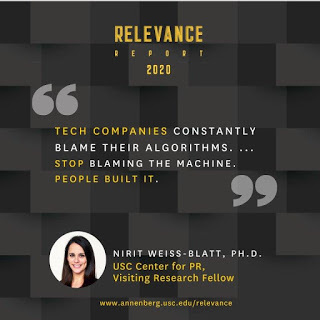
Second, after so many “apology tours,” perhaps tech companies should create a new position titled CAO - a full-time “Chief Apology Officer.” Cynicism aside, saying “sorry” is no longer enough. And even though the companies vowed to fix their issues, a lot of their fixes eventually required further fixing. As both outside critics and their employees put pressure on companies to pay attention to the greater good, they are increasingly being required to address societal issues.
Third, as coverage is moving from “too big to fail” to “too big to fix its problems,” tech companies need to put a greater emphasis on the rigorous corrective actions they are going to implement. A recent poll by Fleishman Hillard found 78% of Americans believe that companies should take more action to address the consequences of their policies, practices, and products to foster trust among consumers. Being ethical by maintaining transparency with customers is an essential step.
Lastly, I still believe that the best outcome of the techlash is that the tech companies are learning to work with governments, academia, and consumers to find solutions. In the long run, this wide collaboration could provide reputational benefits.
* Also published on Medium and the Annenberg website (November 26, 2019).
July 15, 2019
Top Communication Journals - Updated 2019 "Impact Factor" (JCR)
* This post (from May 2015) was updated with the newest rankings.

Throughout the years, I've registered for various communication (& Information Science) journals for their TOC (Table of Content) Alerts. Finally, I decided to arrange them in a list and to check their "impact factor" (in the Journal Citation Report {JCR}, Web of Science Group). The following table is the result :-)
Dear colleagues, for your convenience, I'm publishing it online with all the URLs of the journals.
I hope to update it when needed (impact factor changes) and you are more than welcome to share additional journals.
#
Journal
2019
Impact Factor
Publisher
1
6.302
Taylor & Francis
2
5.912
Taylor & Francis
3
Journal of Computer-Mediated Communication
5.366
Oxford Academic
4
Communication Methods and Measures
5.281
Taylor & Francis
5
4.846
Oxford Academic
6
4.577
SAGE
7
4.577
SAGE
8
Information, Communication & Society
4.559
Taylor & Francis
9
4.476
Taylor & Francis
10
3.843
Taylor & Francis
11
3.758
SAGE
12
International Journal of Advertising
3.606
Taylor & Francis
13
3.540
Oxford Academic
14
3.179
SAGE
15
2.807
SAGE
16
Social Science Computer Review
2.696
SAGE
17
The International Journal of Press/Politics
2.612
SAGE
18
2.494
Oxford Academic
19
Journal of Information Science
2.410
SAGE
20
2.345
Taylor & Francis
21
2.328
SAGE
22
2.321
Elsevier
23
Journalism & Mass Communication Quarterly
2.121
SAGE
24
2.000
SAGE
25
1.965
Taylor & Francis
26
1.905
Oxford Academic
27
Journal of Public Relations Research
1.897
Taylor & Francis
28
International Communication Gazette
1.877
SAGE
29
Mass Communication and Society
1.792
Taylor & Francis
30
International Journal of Public Opinion Research
1.779
Oxford Academic
31
Convergence: The International Journal of Research into New Media Technologies
1.714
SAGE
32
Critical Studies in Media Communication
1.616
Taylor & Francis
33
Journal of Broadcasting & Electronic Media
1.616
Taylor & Francis
34
Journal of Health Communication
1.596
Taylor & Francis
35
1.542
Taylor & Francis
36
Management Communication Quarterly
1.453
SAGE
37
International Journal of Business Communication
1.326
SAGE
38
Journal of Business and Technical Communication
1.207
SAGE
39
International Journal of Communication
1.194
USC Annenberg Press
40
Journal of Applied Communication Research
0.959
Taylor & Francis
--
Corporate Communications: An International Journal
----
Emerald
--
International Journal of Strategic Communication
----
Taylor & Francis
--
----
PRSA
April 10, 2019
“PR:tech” Report – The Glossary
The “USC 2019 Global Communications Report” examines the impact of technology on society and the communication industry. It also provides a glossary of tech companies and tools cited in the survey.
The glossary of “USC 2019 Global Communication Report” provides examples of tech companies and tools for communications and public relations. The definitions were curated from online sources by Manuelita Maldonado (MSPR candidate) and edited by Dr. Nirit Weiss-Blatt (Ph.D.).
The full report is available for download at https://annenberg.usc.edu/gcr.Educators can request printed copies for classroom use by emailing usccpr@usc.edu.
Social Listening and Audience Intelligence
Brandwatch: AI-powered social media monitoring tool that offers business insights based on online conversations, and optimizes targeted influencer, content and paid social media campaigns. In October 2018, Brandwatch announced a merger with Crimson-Hexagon (below).
Crimson-Hexagon: AI-powered consumer insights company that analyzes audiences, tracks brand perception and detects market trends. This multilingual platform covers social networks, blogs, forums, news, and public data sources.
Talkwalker: Social listening and analytics company that uses AI-powered technology to monitor online conversations and images across social networks, news websites, and blogs and forums. Its tool provides brand monitoring, competitive analysis, business intelligence, media response analysis, and early warning systems.
TrendKite: Digital PR platform that uses AI technology to deliver audience insights, provide data-driven reports, conduct market research, and find media contacts to extend a message across paid, owned and shared channels. TrendKite was acquired by Cision in 2019.
Zignal Labs: Media analytics software that uses big data, machine learning and digital media monitoring to measure the impact of earned media projects, identify reputational risks (e.g., bot attacks), and offer a comprehensive competitive analysis for strategic decision-making.
Website Analytics
Google Analytics: Web analytics service inside the Google Marketing Platform brand that tracks and reports website traffic.
SimilarWeb: Online market intelligence platform that tracks apps and website traffic statistics and analytics. It offers customer insights and provides information about a brand’s competitors.
Social Media Management
Hootsuite: Social media management platform that monitors, measures campaign results, and supports content curation and team management.
HubSpot: Inbound marketing and sales platform that provides tools for social media marketing, content management, customer service, web analytics, and search engine optimization.
Spredfast: Social media management software that provides monitoring tools, marketing, and customer care solutions, competitor analysis, and content curation.
Sprinklr: Social media management software that monitors social media channels for advocacy marketing, influencer marketing, social advertising, and customer care through social listening.
Media Monitoring
Cision: Earned media management software for public relations and marketing professionals. It provides online, broadcast, social and print monitoring tools to help businesses measure and analyze the impact of their coverage.
Critical Mention: Media monitoring and reporting platform that delivers real-time broadcast, online and social media content to customers in business, government and non-profit sectors.
Meltwater: AI-driven intelligence platform that provides media and social media monitoring tools. It analyzes billions of online conversations to extract relevant insights, connect with influencers, measure campaign performance, and identify competitors and market trends.
Newswhip: Content discovery and analytics database that tracks and predicts how people engage with stories and trending topics on social media.
Content Creation
Audacity: Free, cross-platform software that allows users to record, edit and combine audio files.
Canva: Graphic design tool that uses a user-friendly drag-and-drop format to design, share and print content. It provides access to a wide array of photographs, graphics, and fonts.
Search Engine Optimization
SEMrush: Online visibility management and content platform that allows brands to build, manage and measure campaigns across all marketing channels. It offers various tools for search, content, social media and video advertising research.
Siteimprove: Software company that offers cloud-based tools to automate the process of identifying errors on websites. It also offers a collection of integrated tools to create high-quality content, drive better traffic to websites, measure digital performance, and work toward regulatory compliance.
SpyFu: Online marketing platform that uses SEO tools and reporting software to analyze competitors, identify top performance metrics, and determine areas for improvement.
Customer Relationship Management and Marketing Automation
Eloqua: Cloud-based software platform for marketing automation that aims to help marketers and organizations manage their campaigns and drive revenue more efficiently. Eloqua is a subsidiary of Oracle Corporation.
Marketo: Marketing automation software that allows businesses to create, automate, manage and track campaigns across web and social media channels. Marketo is an Adobe company.
Salesforce: Customer relationship management platform whose cloud-based applications help businesses track customer information, manage customer support, create personalized marketing campaigns, connect with partners and employees, and access AI-augmented analytics.
SugarCRM: Customer relationship management system that collects critical information across sales, service, and marketing to build better business relationships with customers.
Zoho: Web-based software company that offers a suite of business, collaboration, online productivity, and SaaS (Software as a Service) applications in order to aid a company’s sales, marketing, finance, support, and recruitment needs.
Influencer Identification and Management
BuzzSumo: Online tool that offers social media reports and competitor analysis, and identifies influencer shares, topics, and domains. BuzzSumo was acquired by Brandwatch in 2017.
Creator IQ: Influencer marketing software platform that uses machine learning to identify, measure and validate relevant creators/influencers for social media campaigns.
IzeaX: Platform that connects marketers with influential creators to help automate influencer marketing, analyze campaign performance, and customize content development.
Traackr: Influencer relationship management platform that enables brands to manage, validate, measure and scale influencer marketing programs built on relationships.
Paid Media Planning
Ads Manager for Facebook and Instagram: An online ad management platform developed by Facebook that allows brands to create ads, manage when and where they will run, and track campaign performance.
Google Ads: An online advertising solution that businesses use to promote products and services on Google Search, YouTube, and other sites. Companies can customize their campaigns by setting specific marketing goals, budgets, time frames, audiences, and geographic areas.
Twitter Ads: An online marketing platform developed by Twitter where brands can build tailored campaigns to promote products, increase website traffic, and attract new account followers.
Analytics & Business Intelligence
Qlik Technologies: End-to-end data management and analytics platform that brings together an organization’s data from all sources to provide insights on customer behavior, business processes, revenue streams, and risks and rewards.
Sisense: Business intelligence software that allows users to manage, visualize and analyze complex data from multiple sources in a short amount of time.
Tableau: Business intelligence platform that offers an interactive visual analysis of data in a short amount of time.
News Dissemination & Syndication
Business Wire: Company that disseminates press releases from thousands of companies around the world to news media, financial markets, investors, databases, social networks, and other audiences. It is a subsidiary of Berkshire Hathaway.
Outbrain: Performance-driven discovery and native advertising platform that distributes digital content on publisher sites. It uses behavioral targeting to recommend online content to individual readers.
Taboola: Online advertising platform for content recommendation, audience acquisition, and native advertising. It uses machine-learning algorithms to capture what kind of content is most likely to engage with each individual.
Artificial Intelligence (Tools for Developers)
ONNX.AI (Open Neural Network Exchange): Open ecosystem that allows AI models to be exchanged between different cloud service providers, allowing AI developers to use their models in new places. This project is a collaboration between Microsoft and Facebook and is available on GitHub.
PyTorch: Open-source deep learning platform for Python, based on Torch, often used for natural language processing (NLP). The platform provides a path from research prototyping to productiondeployment. It is primarily developed by Facebook’s AI research group and is available on GitHub.
Tensor Flow: Open-source machine learning software library for high-performance numerical computation. It allows easy deployment of computation across a variety of platforms, servers, and devices. It was originally developed by the Google Brain team and is available on GitHub.
Voice Assistants
Alexa for Business: Amazon virtual assistant that automates and simplifies interactions with technology in a corporate environment. This service is integrated with other platforms, which extends its functionality to other services used in the workplace.
Cortana Skills Kit for Enterprise Developers: Microsoft’s Cortana is a digital assistant that helps users organize and manage daily tasks. With Cortana Skills Kit for Enterprise, businesses can build their own speech bots for different domains.
Google Assistant: An AI-powered virtual assistant that is primarily available on mobile and smart home devices. Third-party developers can use its software development kit (SDK) to extend the appliances and build richer experiences for their users.
SiriKit: API for integrating developer applications with Siri, Apple’s intelligent assistant. The toolkit helps developers to add functionality by building an extension that communicates with Siri.
Conversational Bots
Amazon Lex: Service for building conversational interfaces into any application using voice and text. It uses the same deep learning technologies that power Amazon Alexa to build conversational bots (or “chatbots”).
Live Chat: Live-chat software tool that provides help desk software, customer support, and web analytics. This tool helps e-commerce companies create sales channels to support and engage with website visitors.
Reply.ai: Chatbot building and management platform that helps businesses optimize conversations with clients across channels and websites.
Augmented Reality (AR)
ARCore: Software development kit developed by Google that allows users to build augmented reality applications for Android and iOS devices.
ARKit: Set of software development tools that allow users to build augmented reality applications for iOS.
EasyAR: Platform where users can develop augmented reality applications for Android, iOS, UWP, Windows, Mac and Unity Editor.
Virtual Reality (VR)
Oculus VR: Company that specializes in virtual reality software and hardware products. It is a division of Facebook Technologies. In 2015, Oculus partnered with Samsung to create the Samsung Gear VR for the Samsung Galaxy smartphones.
********
About the Global Communications Report The Global Communications Report is produced annually by the USC Annenberg Center for Public Relations, in conjunction this year with Union Pacific, Worldcom Public Relations Group, Davis & Gilbert LLP, Arthur W. Page Society, Global Alliance for Public Relations and Communications Management, IABC, International Association for Measurement and Evaluation of Communication, International Communications Consultancy Organization, Institute for Public Relations, MCC Consulting, PRCA, PR Council, PRSA and PRSSA. The survey of PR professionals, educators and students is designed to provide insight into the evolution of the global communications industry.
About the USC Center for Public Relations Based at the USC Annenberg School for Communication and Journalism, the USC Center for Public Relations (CPR) connects corporations, agencies, academics and students to define the future of our industry and to develop those who will shape it. Signature initiatives include the Global Communications Report, USC Annenberg’s Kenneth Owler Smith Symposium, and the Relevance Report. Follow CPR @Center4PR and #PRFUTURE.

“PR:tech” Report Findings – Part #2
The “USC 2019 Global Communications Report” examines the impact of technology on society and the communication industry. This post summarizes the findings regarding news content written by AI, tech tools for PR, leading platforms, required tech skills, and the negative impact of tech changes.
Every year, the USC Annenberg School for Communication and Journalism takes a fresh look at the topics and trends shaping the future of the Public Relations industry. Each time we survey professionals working in the field, we discover new insights into what makes PR one of the most dynamic professions in the universe. This year was no exception as we examined the impact of communication technology – what it means for the industry, academia, and society.
In the previous post and this one, I’m providing a glimpse into this new “PR:tech” report findings. The report is based on a comprehensive survey of more than 2,100 public relations leaders, CEOs, and students worldwide.
The rest of the report is available for download at https://annenberg.usc.edu/gcr.Educators can request printed copies for classroom use by emailing usccpr@usc.edu.
So, let’s dive to some of the results and insights:
News Content Written by Artificial Intelligence
PR professionals recognize that artificial intelligence is altering the media landscape, but they don’t realize how quickly it’s happening. They predict about 35% of financial reporting will be written by robots in five years, but Bloomberg reports that 30% of their financial stories are already developed by AI. Students predict a greater percentage of robot journalism in the future, but even they may be surprised by the pace of change.
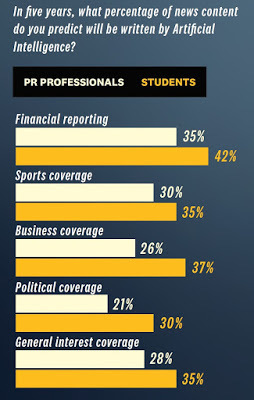 USC 2019 Global Communication Report: https://bit.ly/2Gb33AL
USC 2019 Global Communication Report: https://bit.ly/2Gb33ALBloomberg uses a system called Cyborg, which according to The New York Times is able to assist reporters in churning out thousands of articles on companies’ earnings each quarter. The program can dissect a financial report the moment it appears and spit out an immediate news story. In addition to covering earnings for Bloomberg, robots report on minor league baseball for The Associated Press, high school football for The Washington Post and earthquakes for the Los Angeles Times. These machines aren’t yet replacing reporters, but they are helping them modernize the more mundane aspects of their jobs.
As AI technology spreads, the PR industry will learn how to write press releases that optimize algorithms to ensure the most accurate, positive outcome possible (by the way, fancy diagrams don’t compute). In a few years, PR robots may pitch media robots, but will they meet for lunch?
Main Objectives for New Technology
Tech is also important at the top of the organization. Asked what aspects of their communications they would like to advance through future technology, the vast majority of CEOs stuck with tangible business goals. One-third chose customer experience optimization as a primary objective, which opens a whole new area of opportunity for PR professionals – CXPR, where discrete communication is built into each interaction a customer has with a brand.
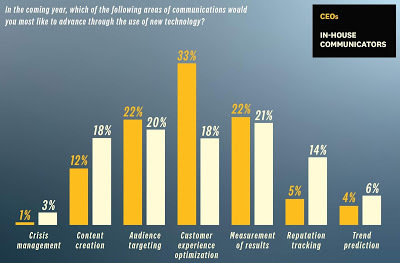 USC 2019 Global Communication Report: https://bit.ly/2Gb33AL Customer experience was followed by audience targeting (22%) and measurement of results (22%), which are the beginning and end of that journey. Less clear-cut activities like reputation tracking, trend prediction, and crisis management were chosen by fewer than 5% of the CEO respondents.
USC 2019 Global Communication Report: https://bit.ly/2Gb33AL Customer experience was followed by audience targeting (22%) and measurement of results (22%), which are the beginning and end of that journey. Less clear-cut activities like reputation tracking, trend prediction, and crisis management were chosen by fewer than 5% of the CEO respondents.In-house communicators are also planning to marshal technology around the customer. Measuring results is their main objective for new technology, which may finally quantify the real impact of storytelling.
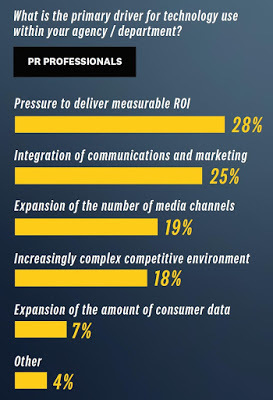 USC 2019 Global Communication Report: https://bit.ly/2Gb33AL
USC 2019 Global Communication Report: https://bit.ly/2Gb33ALMarketing and measurement continue to surface as the key factors in driving the adoption of new technology. The competitive environment is also a big factor for PR agencies who now regularly compete with ad agencies, digital firms, and management consultants, all with deep roots in tech.
Current Ability to Use the Latest Technology
It’s clear that technology has become a critical component of corporate communications for today’s CEOs, and many are relatively pleased with the results. 44% of CEOs surveyed rate their company’s use of the latest communication technology as excellent or good, with 46% admitting to average or below. In-house communicators give themselves significantly lower scores, while agencies think they are more advanced.
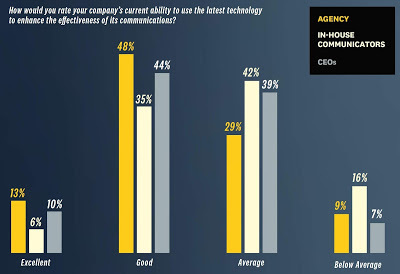 USC 2019 Global Communication Report: https://bit.ly/2Gb33AL
USC 2019 Global Communication Report: https://bit.ly/2Gb33ALAll three groups view new technology as a valuable investment in achieving their future business goals, but experience says we have a long way to go.
Importance of Technological Tools – Current Work vs. Future Work
The number of tools available to the PR professional is growing exponentially. But few are viewed as very important to the communications work currently being done. In fact, media monitoring services like Cision and Zignal Labs, which have been around for years, are ranked as important tools being used today and tomorrow.
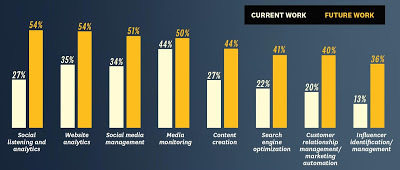 USC 2019 Global Communication Report: https://bit.ly/2Gb33AL
USC 2019 Global Communication Report: https://bit.ly/2Gb33ALBy contrast, newer technologies – like Virtual Reality, Augmented Reality and Voice Assistants – are not considered important to current work by roughly two-thirds of PR executives. Customer Relationship Management, Search Engine Optimization and Web Analytics fall somewhere in between, and the importance of those tools is expected to increase dramatically in the coming years.
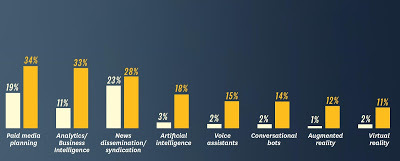 USC 2019 Global Communication Report: https://bit.ly/2Gb33AL
USC 2019 Global Communication Report: https://bit.ly/2Gb33ALSocial media tools show the biggest jump in importance from the present to the future, which tracks with the growing importance of that media channel. Over half of the respondents expect social listening and influencer identification platforms will be very important tools for PR professionals in the future.
Artificial Intelligence and the PR Industry
Interestingly and perhaps alarmingly, only 18% of all PR executives believe artificial intelligence, which is being heralded as the next big thing, will be a very important technology for them in the future.
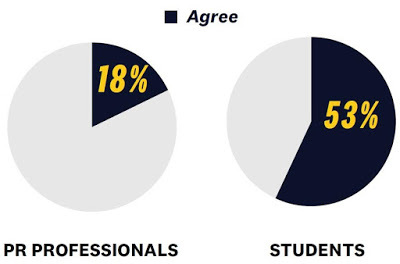 USC 2019 Global Communication Report: https://bit.ly/2Gb33AL
USC 2019 Global Communication Report: https://bit.ly/2Gb33ALBut that may be because only 3% claim to be very knowledgeable about potential AI applications.
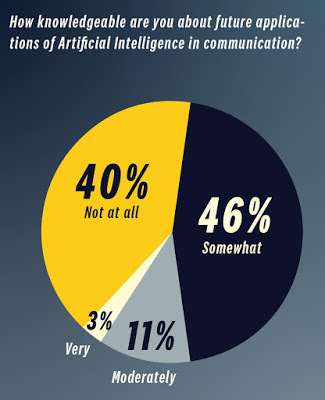 USC 2019 Global Communication Report: https://bit.ly/2Gb33AL
USC 2019 Global Communication Report: https://bit.ly/2Gb33ALMost PR people are confused by the concept of artificial intelligence. Futuristic visions of “Terminator,” “Blade Runner” and “Ready Player One” can be scary, but that world is a long way off. Today, without even realizing it, we’re using AI every day for many mundane activities: asking Siri about the weather, receiving a recommendation from Amazon or requesting an Uber X. These tasks are made possible by machine learning.
For the communications profession, AI is mainly an analytics tool that allows us to do quantitative analysis of massive amounts of data – with the hope of making our strategies smarter, our results better and our jobs easier.
Most of the tools listed in the glossary of this report (also in here) are built on some form of artificial intelligence, and they will profoundly change the way we think and work.
The PR industry will benefit from artificial intelligence, but we must also be aware of its drawbacks. Open AI, a non-profit research organization, founded by Elon Musk and Sam Altman, recently developed a transformer-based language model called GPT-2, which is trained to predict the next word based on all the previous words in a text. Given a simple prompt, the model is capable of generating a page or two of human-quality text. Despite the technology’s potential business applications, Open AI has declined to release the latest version to the public, citing a concern that it might be used to “develop deceptive, biased or abusive language at scale.”
Meanwhile, Gltr, an MIT-IBM Watson Lab/Harvard NLP joint project, analyzes texts and predicts whether it was written by a machine.
The Leading Communications Platforms
When it comes to communications platforms that will be most important in the future, pictures tell the story. YouTube and Instagram, whose popularity is based on photographs and videos, are projected to be the big winners in an era of decreasing attention span.
Google, an AI leader offering a portfolio of technology tools, is not far behind. While visual experiences will rule, text-based platforms may not: A mere 5% feel Medium will be an important communications platform in five years.
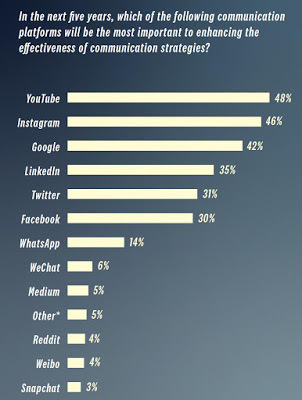 USC 2019 Global Communication Report: https://bit.ly/2Gb33AL
USC 2019 Global Communication Report: https://bit.ly/2Gb33ALDue to the greater number of responses from North America and Europe addresses, it’s certain that WeChat and Weibo are under-indexed in these totals.
Those who chose “other” predict the dominant platform of the future has yet to be invented!
Technology Skills for Successful PR
As the PR profession adopts new technology, PR professionals will need to adopt new skills. Machines may do the analysis, but intelligent humans will be required to translate data into actionable insights. Those insights will be expressed visually, which increases the need for production and design capabilities.
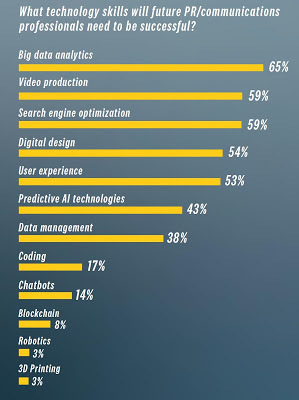 USC 2019 Global Communication Report: https://bit.ly/2Gb33AL
USC 2019 Global Communication Report: https://bit.ly/2Gb33ALContemporary undergraduate PR programs teach coding, analytics and video production, which means a stream of tech-savvy recruits are coming to the rescue. But the technology transformation must be initiated by corporate and agency leaders, who have the authority and the resources to make it a reality.
Technological Changes in Media will Make Average Citizens More – Engaged, Misinformed, Polarized
PR professionals have a mixed view on the long-term impact communication technology will have on those who are on the receiving end of it. 61% agree that the average consumer of information will become more engaged, which is a good thing. But the same percentage (61%) believe that their engagement will be based on misinformation, which is not a good thing. As a result, almost three-quarters (74%) see society becoming more polarized in the future, which seems impossible based on the divisiveness we are already experiencing today.
Students are more optimistic: Only 43% predict the average citizen will be more misinformed and 53% say they will be more polarized.
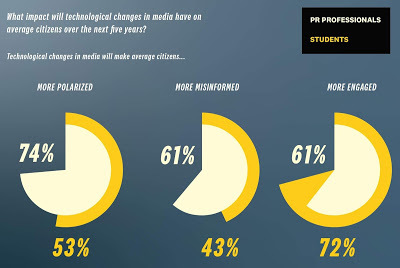 USC 2019 Global Communication Report: https://bit.ly/2Gb33AL
USC 2019 Global Communication Report: https://bit.ly/2Gb33ALThese statistics highlight the power of communication technology, especially when employed to promote a controversial point of view or disseminate misleading information. Communications professionals have a profound obligation to use these new tools responsibly and to denounce those who do not.
Importance of Technology vs. Human Capital in the Communication Industry
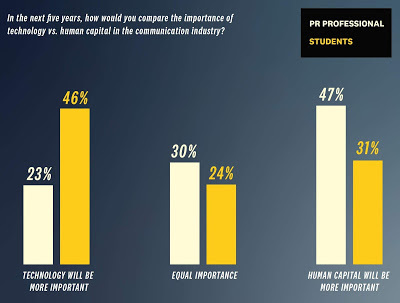 USC 2019 Global Communication Report: https://bit.ly/2Gb33AL
USC 2019 Global Communication Report: https://bit.ly/2Gb33ALAl Golin wasn’t a fan of social media. He preferred high-touch to high-tech. He believed in building relationships face-to-face, rather than on Facebook. But there is no turning back. Technology is our future and tomorrow’s leaders will embrace it. For a long time, we’ve championed the art of Public Relations. To remain relevant to our companies and our clients, we must combine that art with science.
At the same time, we need to remember that our job is to build relationships. Relationships between companies, brands, and people. PR professionals have unparalleled insight, not shared by any other discipline, into the elements of human connection. We know how to listen, and we know how to tell stories. Technology will enhance these skills, but it will never replace them.
********
About the Global Communications Report The Global Communications Report is produced annually by the USC Annenberg Center for Public Relations, in conjunction this year with Union Pacific, Worldcom Public Relations Group, Davis & Gilbert LLP, Arthur W. Page Society, Global Alliance for Public Relations and Communications Management, IABC, International Association for Measurement and Evaluation of Communication, International Communications Consultancy Organization, Institute for Public Relations, MCC Consulting, PRCA, PR Council, PRSA and PRSSA. The survey of PR professionals, educators, and students is designed to provide insight into the evolution of the global communications industry.
About the USC Center for Public Relations Based at the USC Annenberg School for Communication and Journalism, the USC Center for Public Relations (CPR) connects corporations, agencies, academics and students to define the future of our industry and to develop those who will shape it. Signature initiatives include the Global Communications Report, USC Annenberg’s Kenneth Owler Smith Symposium, and the Relevance Report. Follow CPR @Center4PR and #PRFUTURE.



